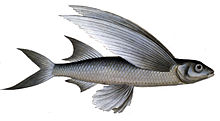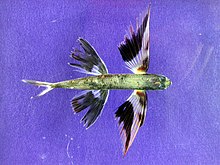Flying fishes
| Flying fishes | ||||||||||||
|---|---|---|---|---|---|---|---|---|---|---|---|---|

|
||||||||||||
| Systematics | ||||||||||||
|
||||||||||||
| Scientific name | ||||||||||||
| Exocoetidae | ||||||||||||
| Rafinesque , 1810 |
Flying fish (Exocoetidae) are bony fish from the order of the garfish-like , which with their wing-like fins are equally well adapted to gliding through water and air. Flying fish are found in tropical and subtropical regions of the Atlantic , Indo-Pacific and the Mediterranean .
Features of the flight
In contrast to the South American hatchet-bellied tetra , flying fish cannot hit their pectoral fins in order to fly actively like birds (see flapping flight ). You catapult yourself out of the water with one jump and glide short distances over the surface of the water. The fish reach the furthest flight distances when they glide through the air very close to and parallel to the surface of the water: Gliding at a height of 1.5 meters, the fish can stay in the air for over 30 seconds and cover distances of up to 400 meters . The flight performance based on aerodynamics is comparable to that of birds. Occasionally they can glide at speeds of up to 70 km / h and altitudes of up to five meters, so that they sometimes end up in low boats.
Gliding through the air is generally interpreted as escape behavior from predators .
anatomy
Flying fish have exceptionally large pectoral fins set high on their bodies . In the subfamily Cypselurinae, the pelvic fins are also enlarged like wings, so that four wings are available for gliding flight. The shoulder girdle and chest muscles are very strong. The caudal fin is deeply split, the lower lobe longer than the upper. The upper and lower jaws of the flying fish, in contrast to most other garfish species, are of the same length, the mouth is terminal and cannot be extended. Only the fry of some species have elongated mandibles. The body resembles that of the herring-like and is covered by large, gently sloping scales. The relatively large nostril is right in front of the eyes. The swim bladder is not chambered and also large.
Flying fish stay on average smaller than 30 centimeters, the largest subspecies Cheilopogon pinnatibarbatus californicus reaches a length of 45 centimeters.
Reproduction
They stick their eggs, some of which are provided with adhesive threads ( not with Exocoetus ), to floating objects such as driftwood, sargassum or floating pumice stone . On the Coromandel Coast, fishermen attract flying fish by hanging bundles of straw in the water as a spawning area.
Internal system
There are four subfamilies, seven genera and about 75 species. The genus Oxyporhamphus , originally regarded as a basal flying fish, is now classified as half-beak (Hemiramphidae). According to a phylogenetic study, Oxyporhamphus belongs to the half- beak genus Hemiramphus .
|
Relationships within the Exocoetidae according to Lewallen et al. 2011.
|
- Subfamily Fodiatorinae, eggs with very long adhesive threads.
- Genus Fodiator Jordan & Meek, 1885
- Fodiator acutus ( Valenciennes , 1847)
- Fodiator rostratus ( Günther , 1866)
- Genus Fodiator Jordan & Meek, 1885
- Subfamily Parexocoetinae ( Hawaiian mālolo ), eggs with adhesive threads.
- Genus Parexocoetus Bleeker, 1866
- Parexocoetus brachypterus (Richardson, 1846)
- Parexocoetus hillianus (Gosse, 1851)
- Parexocoetus mento (Valenciennes in Cuvier & Valenciennes, 1847)
- Genus Parexocoetus Bleeker, 1866
- Subfamily Exocoetinae, eggs without adhesive threads.
- Genus Exocoetus Linnaeus, 1758
- Exocoetus gibbosus Parin & Shakhovskoy, 2000
- Exocoetus monocirrhus Richardson, 1846
- Exocoetus obtusirostris Günther, 1866
- Exocoetus peruvianus Parin & Shakhovskoy, 2000
- Swallowfish ( Exocoetus volitans ) Linnaeus, 1758
- Genus Exocoetus Linnaeus, 1758
- Subfamily Cypselurinae ; "Four-winged" genera, eggs with very long adhesive threads.
- Genus Cheilopogon Lowe, 1841
- Cheilopogon abei Parin, 1996
- Cheilopogon agoo ( Temminck & Schlegel , 1846)
- Cheilopogon antoncichi (Woods & Schultz, 1953)
- Cheilopogon arcticeps ( Günther , 1866)
- Cheilopogon atrisignis (Jenkins, 1903)
- Cheilopogon cyanopterus ( Valenciennes , 1847)
- Cheilopogon doederleinii ( Steindachner , 1887)
- Cheilopogon dorsomacula (Fowler, 1944)
- Cheilopogon exsiliens ( Linnaeus , 1771)
- Cheilopogon formosus Kotthaus, 1969
- Cheilopogon furcatus ( Mitchill , 1815)
- Cheilopogon heterurus ( Rafinesque , 1810)
- Cheilopogon hubbsi (Parin, 1961)
- Cheilopogon intermedius Parin, 1961
- Cheilopogon katherinae Shakhovskoy & Parin, 2019
- Cheilopogon katoptron ( Bleeker , 1866)
- Cheilopogon marisrubri Shakhovskoy & Parin, 2019
- Cheilopogon melanurus (Valenciennes, 1847)
- Cheilopogon milleri (Gibbs & Staiger, 1970)
- Cheilopogon nigricans (Bennett, 1840)
- Cheilopogon papilio (Clark, 1936)
- Cheilopogon pinnatibarbatus (Bennett, 1831)
- Cheilopogon pitcairnensis (Nichols & Breder, 1935)
- Cheilopogon rapanouiensis Parin, 1961
- Cheilopogon simus (Valenciennes, 1847)
- Cheilopogon spilonotopterus (Bleeker, 1866)
- Cheilopogon spilopterus ( Valenciennes , 1847)
- Cheilopogon suttoni (Whitley & Colefax, 1938)
- Cheilopogon unicolor (Valenciennes, 1847)
- Cheilopogon ventralis (Nichols & Breder, 1935)
- Cheilopogon xenopterus (Gilbert, 1890)
- Genus Cypselurus Swainson, 1838
- Cypselurus angusticeps Nichols & Breder, 1935
- Cypselurus bosha Shakhovskoy & Parin, 2019
- Cypselurus callopterus ( Günther , 1866)
- Cypselurus comatus ( Mitchill , 1815)
- Cypselurus hexazona ( Bleeker , 1853)
- Cypselurus hiraii Abe, 1953
- Cypselurus naresii (Günther, 1889)
- Cypselurus oligolepis (Bleeker, 1866)
- Cypselurus olpar Shakhovskoy & Parin, 2019
- Cypselurus opisthopus (Bleeker, 1866)
- Cypselurus poecilopterus (Valenciennes, 1847)
- Cypselurus starksi Abe, 1953
- Genus Hirundichthys Breder, 1928
- Hirundichthys affinis (Günther, 1866)
- Hirundichthys albimaculatus (Fowler, 1934)
- Hirundichthys coromandelensis (Hornell, 1923)
- Hirundichthys indicus Shakhovskoy & Parin, 2013
- Hirundichthys marginatus (Nichols & Breder, 1928)
- Hirundichthys oxycephalus (Bleeker, 1852)
- Hirundichthys rondeletii (Valenciennes in Cuvier & Valenciennes, 1847)
- Hirundichthys socotranus (Steindachner, 1902)
- Hirundichthys speculiger (Valenciennes in Cuvier & Valenciennes, 1847)
- Genus Prognichthys Breder, 1928
- Prognichthys brevipinnis (Valenciennes in Cuvier & Valenciennes, 1847)
- Prognichthys gibbifrons (Valenciennes in Cuvier & Valenciennes, 1847)
- Prognichthys glaphyrae Parin, 1999
- Prognichthys occidentalis Parin, 1999
- Prognichthys sealei Abe, 1955
- Prognichthys tringa Breder, 1928
- Genus Cheilopogon Lowe, 1841
Trivia
- In the film The Future Is Wild have the flying fish in 200 million years ago to air inhabitants, the Flischen developed.
literature
- Joseph S. Nelson : Fishes of the World , John Wiley & Sons, 2006, ISBN 0-471-25031-7
- Kurt Fiedler: Textbook of Special Zoology, Volume II, Part 2: Fish , Gustav Fischer Verlag Jena, 1991, ISBN 3-334-00339-6
Individual evidence
- ↑ Hyungmin Park, Haecheon Choi. Aerodynamic characteristics of flying fish in gliding flight. Journal of Experimental Biology, 2010; 213: 3269-3279 doi: 10.1242 / jeb.046052
- ↑ NR Lovejoy, M. Pour Iran, BB & Collette; Phylogeny and Jaw Ontogeny of Beloniform Fishes PDF
- ↑ Eric A. Lewallen, Robert L. Pitman, Shawna L. Kjartanson & Nathan R. Lovejoy: Molecular systematics of flyingfishes (Teleostei: Exocoetidae): evolution in the epipelagic zone. Biological Journal of the Linnean Society, 2011, 102, 161-174.
- ↑ mālolo in Hawaiian Dictionaries
Web links
- Flying fish on Fishbase.org (English)
- Life - Flying Fish (YouTube video)






